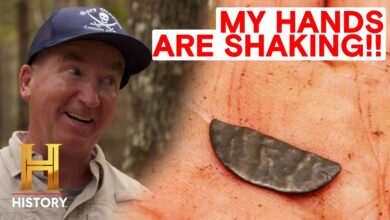Oak Island Team Finds Clue That Might Finally Unlock the Treasure Vault!
Oak Island Team Finds Clue That Might Finally Unlock the Treasure Vault!

Researchers find critical clue to money pit mystery.
After long and extended hours of searching, it looks like the research team has finally gotten a clue to the treasure in the money pit.
Rick Lagina, Tom Nolan, another landowner on Oak Island, and the other members of the team are getting ready to undertake another dig on lot 13, which is located just northeast of the marsh. They are looking for crucial evidence.
Clay was discovered, but it was rather clear that it shouldn’t have been in that location in the first place. They hypothesized that it might be some kind of blue clay.
Rick Lagina and other members of the team have just uncovered what may turn out to be a critical clue to money pit mystery when they were digging a peculiar boulder formation known as the quadrilateral.
In the year 1804, when researchers began the first significant excavation of the original money pit, they did so at a depth of 40 ft. There, at that depth, they discovered a layer of blue clay that served as a sealant to prevent water from entering the pit.
Curiously, the identical chemical was found by the researchers in 2018 when they studied a circular structure of stones called the eye of the swamp.
Is it feasible that the crew has now discovered evidence that the quadrilateral was produced by the same persons that modified the swamp and erected the money pit? If so, this would be a very interesting development. It reminded them a little bit of what they had seen in the money pit, if that makes any sense.
The historical account of the discovery of the money pit includes blue clay as an important component. Would that be something you would take advantage of if you were trying to prevent water from getting into a subterranean construction of some kind?
The hypothesis put up by Rick Lagina, according to which the existence of blue clay suggests the possible existence of a structure buried below, could be valid. If that’s the case, what kind of building may it be? And might it possibly hold something of exceptional value?
Rick Lagina and other members of the crew went back to lot 13 the following morning so that geoscientist Dr. Ian Spooner could investigate the mysterious quadrilateral feature which was giving a critical clue to money pit mystery.
They had the impression that it was somewhat unlikely for it to have organically accumulated in that location. They also spotted clay of several colors that had bits of charred wood mixed in with it. These two things absolutely do not belong together in any way.
It was suggested by one of the members of the group that the clay was broken up and out of place. Something that served a significant purpose took place in that location. Because it’s such a convoluted tale, there really must be a reason for everything that happened.
There was one tiny area that had experienced some deterioration. The metal was marked with striations all over it. The tips appeared to be quite thin, suggesting that they were intended to be driven into wood—a staple or a fastener made of hand-forged iron.
Large metal staples have been utilized in the construction of stone and wooden structures on a regular basis for as long as the 6th century BC. Could this hand-forged metal fastener be another evidence that a structure of some type is lying in wait to be exposed at the location referred to as the quadrilateral?
In that case, assuming that the group has already discovered blue clay, what sort of building could it be given that information? Anything that happened before the first discovery of the money pit has a possibility for something that may be considered original work.
When you compare this so-called staple to the painstaking effort that was required to produce the great quadrilateral, you will notice that it is in fact extremely perplexing. In what ways, if any, does this aspect contribute to the bigger mystery that has not been decided at this time?
Rick and Marty Lagina, together with Craig Tester and archaeometallurgist Emma Culligan, meet with blacksmithing expert Carmen Leg at the Oak Island Interpretive Center to have him examine the enormous metal staple that was uncovered the previous day.
The place where it originates is a wonderful quadrilateral. They had no idea what the particular feature meant despite the fact that it was an unusual geometric figure. It is the first one of its kind that they have discovered on the island.
There are currently an infinite number of speculations on the nature of the treasure that may be located on the island as well as the process by which it arrived there. However, the William Fipps theory has many people persuaded, and there is substantial evidence to back the assertion.
Hammerson Peters, a writer and history enthusiast, debunked the hypothesis in a video that he uploaded to his YouTube channel not long ago. The book Oak Island and its Lost Treasure, which originally put up the compelling argument for the conspiracy, is where the majority of the information shown in the film comes from.
The Peters have put out a notion that can be summarized as follows. William Fipps was an accomplished explorer during the 17th century, and the English provided financial support for his travels. When King James II came to power in 1685, the Protestant majority, including political leaders and aristocracy, had a strong aversion to the Catholic monarch. James II was a Catholic.
To put it another way, they intended to remove him from power due to the fact that very little material that has been independently confirmed exists regarding the early treasure-related operations that took place on Oak Island. The following narratives are word-of-mouth legends that date back to the late 18th century. Publishers didn’t start paying attention to this kind of action and investigating the stories involved until many decades after it had already occurred.
The story of a treasure discovered by a settler called Daniel McInness first appeared in print in the year 1857. This is the first known version of the tale. After then, it took an additional 5 years until one of the claimed original diggers provided a statement about the first narrative as well as future Enslow and Truro company actions.
The first inhabitants of the area told a story about a dying sailor who was part of Captain Kid’s crew. The man said that Captain Kid had buried treasure on the island that was worth 2 million pounds. Captain Kid died in 1701.
The most frequently accepted version of the account of how gold was discovered states that Daniel McInness came upon a dip in the earth in the year 1799 when he was seeking a site for a farm. McInness, who felt that the depression was in line with the myth about Captain Kid, requested assistance from other people in order to dig.
He excavated the pit and, with the help of two individuals only known as John Smith and Anthony Vaughn, uncovered a layer of flagstones 2 ft (61 cm) below the surface. However, the oldest records only describe marks of some kind at these intervals.
Later stories state that oak platforms were found at every 10 ft (3 m) interval, while the earlier ones just mention marks. The tool marks or pick scratches on the walls of the hole were also reported in the different stories.
The ground was obviously loose and, compared to the surrounding soil, it was not as hard-packed. According to the account, the three guys stopped digging at a depth of 9.1 m (30 ft), owing to superstitious dread.
In a different take on the plot, all four of the main characters are depicted as being teens. In this interpretation, McInness discovers the depression for the first time in 1795 as he is out on a fishing trip. The remainder of the narrative follows the same pattern as the first, which involves the discovered logs, but it culminates with the four people quitting after they have dug as far as they are able to.
Do not forget to subscribe for more up-to-date discovery content.
They continued the dig down to approximately 90 ft (27 m), finding layers of logs or marks roughly every 10 ft (3 m) apart. In addition, they uncovered layers of charcoal, putty, and coconut fiber, as well as a big stone that had symbols carved into it.
The situation became difficult for the diggers when the hole suddenly filled with water to a depth of 60 ft (18 m) for no apparent cause. After several failed attempts by laborers to get the riches from below by excavating a tunnel beginning at a second shaft that was similarly inundated, the purported excavation was finally given up and abandoned.
The Truro Company, which was rumored to have been established in 1849 by a group of investors, is considered to have been the most successful unpublished era business. The hole was re-excavated all the way down to the level that was 86 ft (26 m) below the surface, but it ended up overflowing once again.
After that, it was decided to use a pod augur to drill five boreholes into the original shaft of the machine.
Researchers just discovered what seems to be a strange being in space. Curse of the island.
With careful research, strategic planning, and a shared dedication, the Lagina Brothers have become synonymous with the relentless chase of a dream that has gone beyond television screens and reached a global audience.
Marching into the undiscovered territories of this island, these brothers have laid their sight on something that no man has ever dared to see: the island’s curse.
The island’s curse, as speculated by many, states that seven men will die before the treasure is found. Its source is unspecified, but the curse appears to have formed over the past 100 years. Some say the figure is as high as 14 people, but we know at least six already.
The first was an unnamed employee of the Oak Island Association who was killed in 1861 when a mechanical drainage pump exploded. In 1897, Maynard Kaiser fell to his death while digging for an excavation company, and from him, four other men fell on the shores of this island.
Rick Lagina and his crew are the seventh so far to be in search of the riches beneath this soil. And although no apparent threat has come to the brothers and their crew on the island in 2017, there was a recorded death of a teenager who was once on the show due to an epileptic seizure.
Although this did not occur in search of the island’s treasure and did not count as one of the deaths of the curse, could this be a sign for the Lagina brothers? Could the curse be true? And is this death warning the brothers to back off from trying to find a cursed treasure?
Well, the Lagina brothers don’t take heed of any curse and are willing to put their lives on the line to fulfill their great desires.
Discovery of a cryptic stone.
In one of the episodes, Rick and Marty stood at the shores of Oak Island with a stone in hand with cryptic symbols marked on it. This stone becomes the most crucial aspect of their exploration—a clear and substantial connection to the mysteries surrounding Oak Island for centuries.
As the brothers dive into the island’s soil, their shovels unearthed dirt and another mystery. A major moment arises when the Laginas come upon an underground tunnel, a secret passage leading to a chamber known as the money pit.
The name befits the pit’s legacy, as it has become a symbol of the huge financial investments and efforts poured into its exploration over the years.
The money pit, layered with the strategic placement of logs dating back centuries, stands as proof of the island’s protective grip on its secrets. What began as a hopeful search for hidden riches evolved into a complex puzzle of tunnels and booby traps, each layer revealing a piece of Oak Island’s mysterious history.
The discovery of the money pit becomes a turning point not just in the Lagina brothers’ journey, but in the larger narrative of Oak Island. It gives a spark of hope, an excitement that perhaps after centuries of doubt, the secrets hidden within the island’s depths are on the verge of revelation.
The initial quest, marked by a mysterious stone and the uncovering of the money pit, sets the stage for a story that captures human curiosity and the relentless chase of the unknown.
Presence of the Romans.
The Lagina Brothers’ quest on Oak Island unfolds like a drama, season after season, with each episode revealing new facts about the island’s hidden history.
Amidst the highs and lows, the brothers unearthed artifacts that captivated audiences and hinted at a rich history predating Christopher Columbus. One of the jaw-dropping moments came with discovering a Roman ceremonial sword.
Imagine the excitement as the Lagina brothers, deep in Oak Island soil, unearthed a relic that suggested a connection to the mighty Roman Empire. This genuine revelation could rewrite the timeline of Oak Island’s history, indicating a pre-Columbian presence that challenges conventional historical narratives.
The unearthing of a coin bearing the unmistakable Knights Templar’s cross added to the interest. This finding opened a portal to doubts, suggesting a connection between Oak Island and this secretive medieval order.
The Knights Templar, known for their mysterious quests and legendary treasures, brought an element of mystery that fueled the Lagina brothers’ determination and viewers’ fascination. These artifacts weren’t just physical remains, but keys unlocking doors to Oak Island’s past.
The Roman sword hinted at a potential pre-Columbian connection, while the Knights Templar’s coin suggested a connection with one of history’s most mysterious and influential organizations.
The seasonal dramas weren’t just about uncovering tangible objects, but about piecing together a puzzle that spanned centuries. With every find, the Lagina brothers were uncovering Oak Island’s rich tapestry, revealing a history that went beyond the known explorations of Christopher Columbus.
In the archives of Oak Island’s seasonal stories, the Roman sword and Templar coin episodes stand as milestones, sparking debates, igniting imaginations, and confirming the belief that this island held secrets beyond the bounds of conventional history.
Ancient French map.
As the Lagina brothers continued their quest, these artifacts became relics and narrative threads, creating a tale of Oak Island’s profound and mysterious past.
In the complex narrative of the Lagina brothers’ Oak Island expedition, season 4 turned out to be a turning point that would reshape the path of their quest. What spurred this pivotal moment was the discovery of a crafted French map from 1647—a revelation that became the Rosetta Stone of their archaeological journey.
Imagine the scene as the brothers uncovered this centuries-old map, its delicate form bearing the weight of untold secrets. This artifact, more than just parchment and ink, became a gateway to new possibilities and mysteries concealed within Oak Island’s mysterious landscape.
Armed with curiosity and a thirst for knowledge, the Lagina brothers found themselves on the verge of solving a code that had escaped explorers for centuries.
Enter Zena Halpern, a historian and seafaring expert whose expertise in decoding symbols became invaluable to the Lagina brothers. Halpern’s role in this incident was similar to a guide illuminating a path through unknown territories. Her knowledge and proficiency provided the crucial link necessary for understanding the nitty-gritty of the French map.
Together with the Lagina brothers, Zena Halpern went on a collaborative effort to unlock the secrets concealed within the 1647 map. Her mastery of decoding symbols and historical context became useful in uncovering the cryptic messages in the cartographic masterpiece.
Once a mystery, the map gradually revealed clues that hinted at the presence of Freemasons and their involvement in the search for hidden treasures on Oak Island.
This collaborative journey, marked by the Lagina brothers’ determination and Zena Halpern’s expertise, showed the power of interdisciplinary collaboration and decoding historical mysteries.
The French map and Halpern’s involvement were not mere plot points, but keystones that unlocked a new chapter in Oak Island’s story.
The expansion of the Lagina team marked a significant turning point in the Oak Island saga, introducing key players like Craig Tester, Dan Blankenship, and his son David—the Oak Island Maze. As the roster grew, so did the complexity of the challenges before the team, turning Oak Island into a maze of mysteries to uncover.
Dan Blankenship, a legendary figure in Nova Scotia with over 50 years of experience, emerged as a crucial asset. His wealth of knowledge and expertise played a major role in decoding booby traps strategically placed on the island and uncovering the long-buried secrets of Smith’s Cove.
Blankenship’s contributions went beyond being a team member. He became a living link to Oak Island’s past, providing invaluable insights that guided the team through the maze.
One of the toughest challenges faced by the expanded team was the need to drain water from the excavation site. This seemingly unachievable task became a crucial point of the team’s efforts. However, with an innovative approach, Craig Tester introduced a game-changing solution—freezing the water.
This unique method displayed the team’s adaptability and showcased their ability to think outside the conventional archaeological toolbox.
With its diverse expertise and collective determination, the expanded team transformed Oak Island from a mere geographical location into a stage for historical exploration. Each member brought a unique set of skills. As the challenges multiplied, so did the determination of the Lagina team, creating a narrative that goes beyond the search for treasures.
Discovery of an ancient text.
In a plot twist that would rival any archaeological thriller, the Lagina brothers came across a revolutionary moment when they came upon an ancient bookbinding on Oak Island. This seemingly harmless discovery uncovered a thread of mystery hinting at a secret message waiting to be decoded.
As they dived into the complexities of this aged binding, the Laginas uncovered an ancient text written in a long-dead language, echoing the whispers of centuries past.
The revelation took a significant turn with the discovery of a parchment that bore the names William Chapel and Frederick Blair. This aged piece of parchment revealed a 15th-century tale detailing a secret vault filled with untold treasures.
This revelation gave the Lagina brothers a roadmap, guiding them through the labyrinth of Oak Island’s secrets. The process of decoding these ancient texts became a quest in itself. With each decoded symbol and translated word, they pieced together a narrative that hinted at secret societies and the prospect of a hidden fortune.
This chapter on Oak Island’s story is not just about artifacts. It’s a testament to the power of language, history, and the search for knowledge.
The Lagina brothers, armed with determination and guided by the cryptic messages of the past, continued their journey into the heart of Oak Island, uncovering its secrets.
As they decoded ancient texts and parchments, they not only decoded the language of the past but added another layer to the never-ending Oak Island mystery.
The renowned money pit also unfolded a tragic chapter in Oak Island’s history. The saga turned dark when the Truro Company, pouring immense funds into the excavation, faced financial depletion.
As resources dried up, the company had no choice but to abandon the pursuit, leaving the money pit as an unfinished quest. The tragedy deepened with the loss of life—an individual who met their untimely end while trying to drain water from the pit.
The money pit, once a symbol of hope and ambition, became a marker of financial and human costs. Its tragic history echoes through the ages, contributing to the mystery surrounding Oak Island and highlighting the challenges and dangers woven into this legendary site’s very fabric.
Could these terrifying discoveries lead to the famous Oak Island treasures? Find out in the coming episodes of the latest seasons of the show.
Thank you for watching. While you are still here, click the video on your screen to see more mind-blowing videos like this one.








